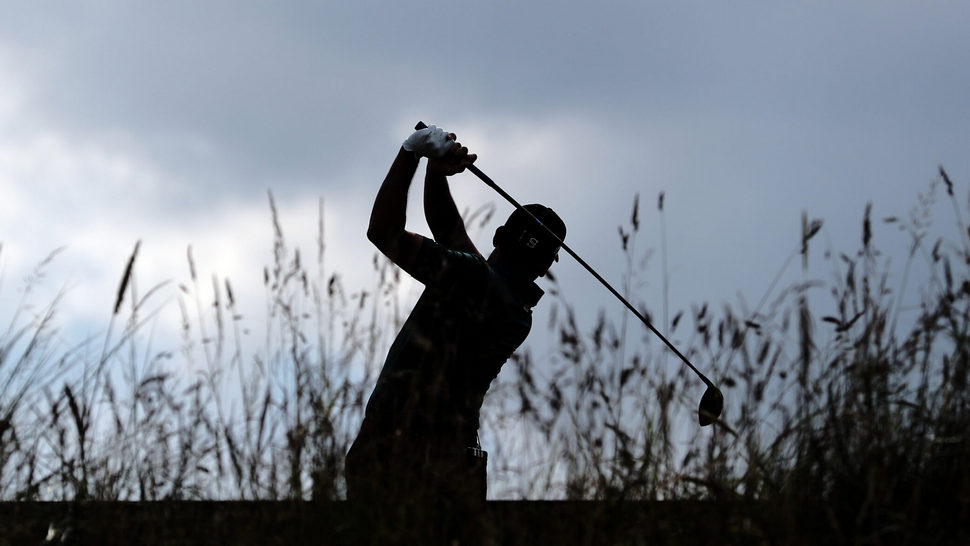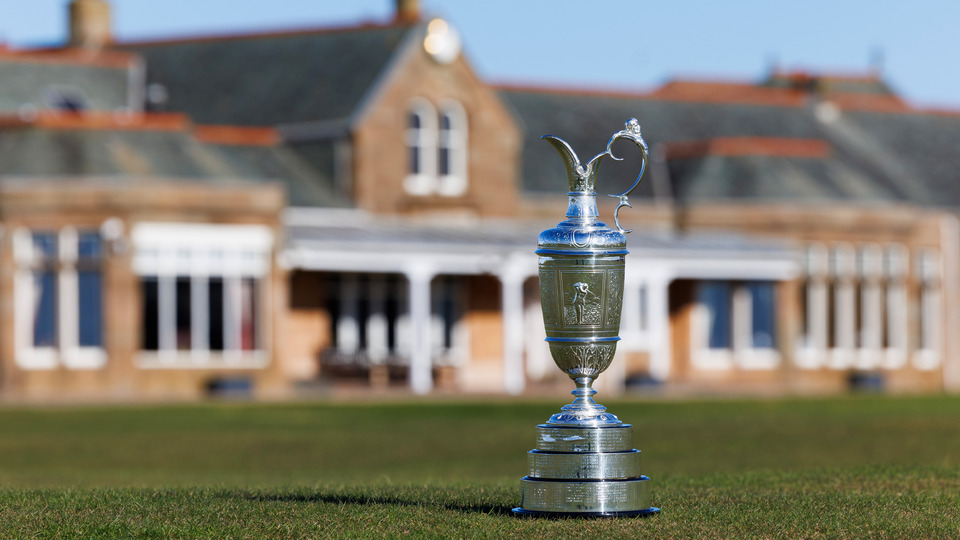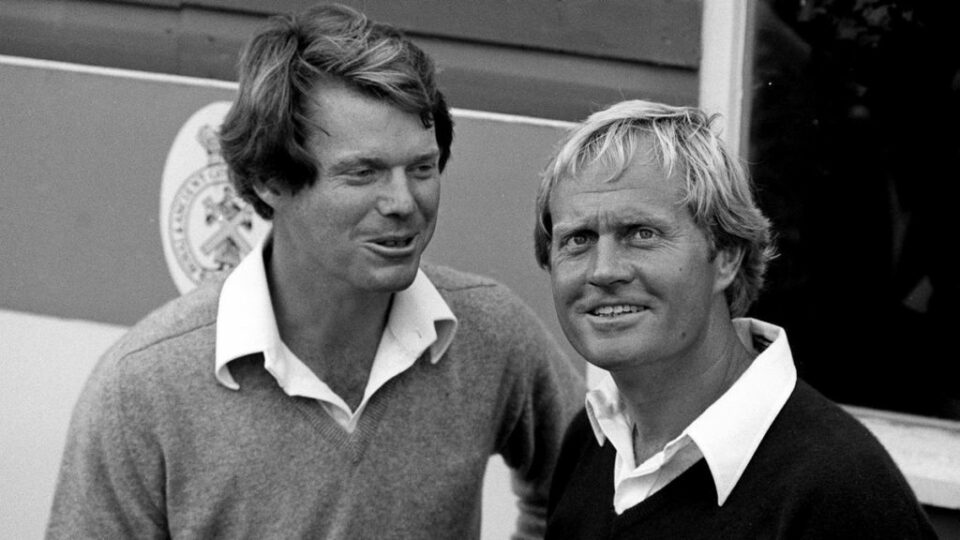The golf swing MUST ACHIEVE three vital conditions in order to be effective.
Few golfers are aware of them, and even fewer actually achieve them and I include pros in this category!
The swing movement that I am about to describe in the following lessons is designed to AUTOMATICALLY produce these three requirements.
A good set-up and address is essential for this purpose
1. Line at impact

The clubhead must be travelling along the intended line of flight through the impact area. Only a correct left-hand and arm swing coupled with a correct body movement can achieve this line down into the ball.
THE DOWNWARD SWING OF THE LEFT HAND AND ARM CREATES THE CORRECT LINE DOWN INTO, AND THROUGH THE BALL.
There is no other way of doing it. Most golfers misuse the body in the swing, thus destroying club-line into the ball. If the club head is not swinging "on-line" you cannot hope to consistently hit straight shots.
2. Square impact

The club-head must swing "on-line", but it must also be square to the intended line of flight through impact AND BEYOND!
To be specific, THE LEADING EDGE of the club (iron or wood) must be square (at right angles) to the intended line of flight through impact, This is largely achieved by a correct grip, and a correct hand action throughout the swing. A correct body movement also contributes to a square impact just as an incorrect one destroys squareness.
3. Off the middle

The ball must be STRUCK OFF THE MIDDLE OF THE CLUB-FACE with both irons and woods.
An "on-line", square impact off the middle of the face is what we must achieve and it is by no means common.
I have seen many tournament pros who are incapable of hitting three consecutive balls off the middle of the face!
Hitting off the heel and toe is a sure sign of an incorrect line through impact. Actually, hitting off the toe is fare more serious a fault than hitting off the "shank", as a club-line is much more "out-to-in" with the toe shots than with the shots off the "pipe".
Thus a correct swing leads to a correct club-line. Correct grip and hand action create a square impact. Given both of these, the ball will come off the middle of the face.
The address position
In taking up the address position we are arranging the body so that we can swing the club-head along the intended line of flight. We are, in effect, adjusting the "aim" of the swing.

We have decided where we want the ball to go, and we have selected the club with the required loft to take it there. We have established the intended line of flight from point A to point B. Now in order to direct the swing along the intended line of flight, we must place the toes level on an imaginary line that is parallel with the intended line of flight.
The shoulders, too, must be parallel with that line.
This parallel arrangement of the toes and shoulders is known as the square stance.
If the right foot alone is drawn slightly back from the line the stance is said to be "closed".
If the left foot alone is drawn slightly back from the line, the stance is said to be "open".
For the vast majority of shots I recommend a strictly square stance. If you want to withdraw the right foot slightly when using a driver, do so. But be sure that your shoulders remain parallel to the intended line of flight.
A closed stance encourages rolling of the hands through impact - which is why most handicappers cannot use a driver. They literally smother the shot.
I will not quarrel with a slightly open stance. But I said slightly - and again- the shoulders must be square.
I strongly recommend you do not experiment with open or closed stances. We want to swing along the intended line of flight so let us stand square to it.
Moving the feet and shoulders about merely alters the direction of the swing, and leads to complications. We are looking for a standardised procedure, remember, so let's adopt a square stance.
Position is mainly a matter of aligning the direction of the swing to the target - "aiming" correctly. It goes without saying that unless we align correctly at address, the ball will not go where we intend it to go.
Few golfers take enough time over this vital alignment, and others think they are correctly aligned when they are not.
When practising, do not shrink from placing a club down on the ground beyond the ball so that it is parallel with the intended line of flight. By using this datum line, you can be sure that you are lining up correctly.
Visit any golf range and you see golfers who have not even selected a target to aim at - so the matter of alignment never arises! This is a sheer waste of time and effort. Always aim at a specific target, and be sure to align correct to it. This is basic common sense.
The questions of direction and distance must be resolved before we settle down to make the stroke. Uncertainty leads to tension and error.
Standing to the Ball
Aligning the club-face to the hands - the arm set is established

We have now established a correct grip and we understand the need for a correct set-up of the arms. We must now learn to address the ball correctly and squarely, incorporating the features we have discussed so far.
First, to establish correct alignment of the club-face to the hands, grip the club correctly and extend the arms and club out in front of you as illustrated. Now check that the elbows "bow" out slightly and then check that the leading edge of the club-face is vertical ( i.e. square) and correctly aligned with the hands.
Now, without altering the angle formed by the shaft and the arms (angle A) lower the head of the club and ground it behind the ball.
Grounding the club

While you are lowering the head of the club you will, of course, bend forward from the waist and flex the knees. This places the club-head roughly equidistant between the feet and club shaft, hands and head, align down the centre of the body. In this way exaggeration at address is avoided.
This method of aligning the face of the club to the hands, and of grounding the club correctly should become routine. It enables us to retain all the features of the set-up that we have considered previously.
This simple drill will automatically ensure a correct position at address, free from stiffness, contortion or exaggeration.
How far from the ball at address? A drill
Many players have difficulty deciding how far from the ball they should stand at address.
Naturally with the woods you will be further from the ball than you are with short irons, but for all types of shots, I recommend a drill which will both place you at the correct distance from the ball, and automatically place the shaft at the correct angle to the ground.
Take up your grip, and square the club-face to it. Now extend the arms and the club straight out in front of you. Avoid any forcing or stiffening of the arms. Remember, the elbows should "bow" out slightly at address. Now, maintaining the angle thus formed between shaft and the arms, ground the club behind the ball and move the feet into position.
Both distance from the ball and shaft angle are now correct - and this drill holds good for all clubs.
In establishing the correct shaft angle, we also resolve the question of the correct position of the hands at address. Far too many players hold their hands too low at address - few hold them too high. Holding the hands low at address is a major cause of excessive wrist action in the swing. A vice to be avoided at all costs!
Build this drill routine into your address procedure and you kill three birds with one stone!

Address procedure
First, stand behind the ball looking in the direction of the intended shot, and establish an imaginary line to the target. At the same time, pick out a distant landmark or object (bush, tree, post, church spire etc) directly beyond the target area to serve as a specific aiming point.
You have already chosen the club to give you the required distance for the shot you intend to play. You now have a specific object at which to aim. Thus direction and distance have been resolved, and you can concentrate solely on the stroke.
While this process of evaluating the shot has been going on, the good player will have been sub-consciously forming his grip on the club, and "feeling" the stroke in his hands. He will check the club-face is squared to his grip, and then he will approach the ball and ground the club behind it.
In grounding the club, he will ensure that the face of the club is square (at right angles) to the intended line of flight.
He will then position his feet with frequent reference to the aiming point that he has previously selected. having placed his feet, he is ready to play his shot.
Note that the positioning of the feet came LAST.
The average golfer often reverses the procedure, placing his feet first, then vaguely grounding the club he juggles with his grip in an attempt to get the club-face square. There is no logical sequence in his method and his last minute grip adjustments account for the fact that his grip is never the same one shot from the next.
We have already said that golf is a game of consistency. So let's be consistent and develop correct routines for everything. Good golf is largely a matter of forming good habits.
Here once again, is the routine:
1. Evaluate the shot
2. Take up your grip and square the club face to it.
3. Ground the club correctly behind the ball.
4. Now place the feet into position.

The arms should bow out slightly at address

The grip, and the set-up of the arms are very closely related. A poor arm set-up makes a good grip more difficult, and a bad grip affects the arm set-up. This is not generally realised.
Contortions of the arms at address are common among golfers, resulting I fear, from bad advice.
Contorted arms are stiff arms, and you cannot freely swing a rigid limb.
I have told you to hold the arms clear of the body. Now, to achieve a correct arm set-up, simply bring the hands together in front of you, palms facing each other (you do not need to hold a club for this) and close the hands as if you were placing them on a club - right hand below the left. Now look at your arms. The first thing you will notice (if they are relaxed) is that the arms bow out slightly at the elbows. This is exactly the set-up we want. Check it in front of a mirror.
There is no straightening or stiffening of the arms whatsoever. Neither is there any twisting inwards of the elbows to bring them close together, as has been advised by some eminent players who do not themselves set the arms that way.
The set-up I require is quite easy to achieve. Don't complicate it needlessly.
It is very important that you achieve the arm set-up that I have described. It will save you a lot of heartache later on, as a poor arm set-up profoundly affects your play.
I have started by correcting the arm set-up of many top players, which has automatically resolved other problems at the top of the swing.
I cannot overstress the importance of a good arm set-up.

Next Lesson - The Backswing



